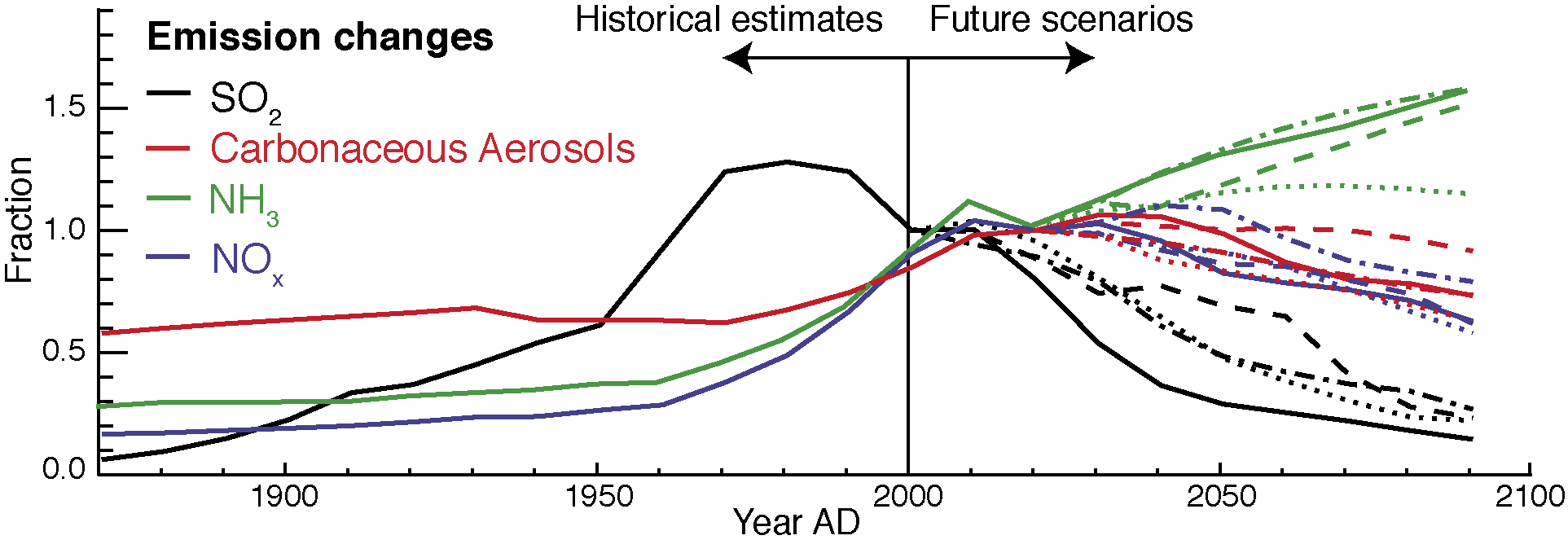- Home
- Publications
- PAGES Magazine
- Aerosols and Climate - How Sensitive Is Earth’s Climate To Atmospheric Aerosols? [Present]
Aerosols and climate - How sensitive is earth’s climate to atmospheric aerosols? [Present]
Samuel Albani and Natalie Mahowald
PAGES news
20(1)
20
2012
Samuel Albani1 and Natalie Mahowald2
1Department of Environmental Sciences, University of Milano-Bicocca, Milano, Italy; show mail address
2Department of Earth and Atmospheric Sciences, Cornell University, Ithaca, USA
Solids or liquids suspended in the atmosphere – aerosols – influence Earth’s climate by interacting directly with radiation, by modifying clouds and by perturbing biogeochemical cycles and atmospheric chemistry. Aerosols consist of sulfates, organic carbon, black inorganic carbon, sea spray, mineral dust, ammonia and nitrates, and are emitted either directly or are formed from gaseous precursors. They are released by fossil fuel combustion, biomass burning or by emissions from the land and ocean surfaces. Aerosols reside in the troposphere for less than a day to a few weeks, and up to a few years in the stratosphere (Mahowald et al. 2011).
We monitor aerosols today using ground-based and satellite-borne remote sensing devices, and by in situ sampling on the ground and via aircraft, both at local and global scales (for example, the NASA Global Aerosol Climatology Project). But, despite the large number of observations of aerosols, there are large uncertainties in their distribution in space and time and their characteristics, because of their variability in space, time and composition (Mahowald et al. 2011; Formenti et al. 2011). In addition, aerosol deposition can be studied using passive natural or human-made collectors, such as snow pits or marine sediment traps (Kohfeld and Harrison 2001). Increasingly complex atmospheric transport and chemistry models and Earth-system models complement the set of tools for the study of the aerosol-climate interactions (Stier et al. 2006).
In its fourth assessment report, the Intergovernmental Panel on Climate Change estimated that anthropogenic aerosols had a net cooling effect on climate, partly offsetting the warming from greenhouse gases. But this conclusion is tempered by the large uncertainties involved. Aerosol-climate interactions thus constitute one of the major sources of uncertainty in assessing the global average radiative forcing (RF; Forster et al. 2007), and contribute to the large uncertainty in climate sensitivity (globally averaged surface temperature change at equilibrium) of between 2 and 4.5°C for doubling of CO2 (IPCC 2007).
Aerosols affect the climate in multiple ways. The direct effect – by scattering and absorption of solar and terrestrial radiation – leads to an RF value of -0.50±0.40 Wm-2 compared to the +1.7±0.1 Wm-2 estimated for rising CO2 levels (Forster et al. 2007). Similarly, this interaction of aerosols with radiation also appears to be contributing to the observed “dimming” or reduction in the amount of incoming solar radiation that reaches the surface (e.g. Haywood et al. 2011). Aerosols interact with clouds by modulating albedo (the “cloud albedo” effect), which causes RF of -0.7 (-0.3 to -1.8) Wm-2, and by modifying cloud lifetime (Forster et al. 2007). Aerosols also modify biogeochemical cycles by providing nutrients that limit primary production (e.g. Martin et al. 1990) and by producing climate alterations, which in turn enhance carbon uptake, affecting climate indirectly with an estimated RF of -0.50±0.40 Wm-2 (Mahowald 2011). In addition, deposition of black carbon and dust modify the albedo of snow (Hansen and Nazarenko 2004).
Natural aerosols are a potent source of feedbacks to the climate (Carlsaw et al. 2010). The impact of stratospheric aerosols on climate is seen in the response of the surface cooling to large volcanic events (e.g. Mt. Pinatubo), which can be as large as -0.2°C globally averaged (Robock 2000). Because of the potency of aerosols for climate perturbation, they are also being considered for tools in geoengineering the climate (e.g. Shepherd et al. 2009).
Humans have significantly increased the amount of aerosol in the atmosphere over the last 130 years. In the future, because of public health concerns as well as efforts to reduce combustion of fossil fuels, it is likely that emissions of anthropogenic aerosols will decrease (Fig. 1). This reduction in aerosols in the future is likely to both increase the rate of warming (Andreae et al. 2005), as well as make reductions in carbon dioxide harder to achieve (Mahowald 2011), because of the complicated and central role of aerosols in modulating climate and biogeochemistry.
selected references
Full reference list online under: http://pastglobalchanges.org/products/newsletters/ref2012_1.pdf
Andreae MO, Jones CD and Cox PM (2005) Nature 435: 1187-1190
Carslaw KS et al. (2010) Atmospheric Chemistry and Physics 10: 1701-1737
Haywood JM et al. (2011) Journal of Geophysical Research 116, doi: 10.1029/2011JD016000
Mahowald N (2011) Science 334, 794-796
Mahowald N et al. (2011) Annual Reviews of Environment and Resources 36: 45-74
